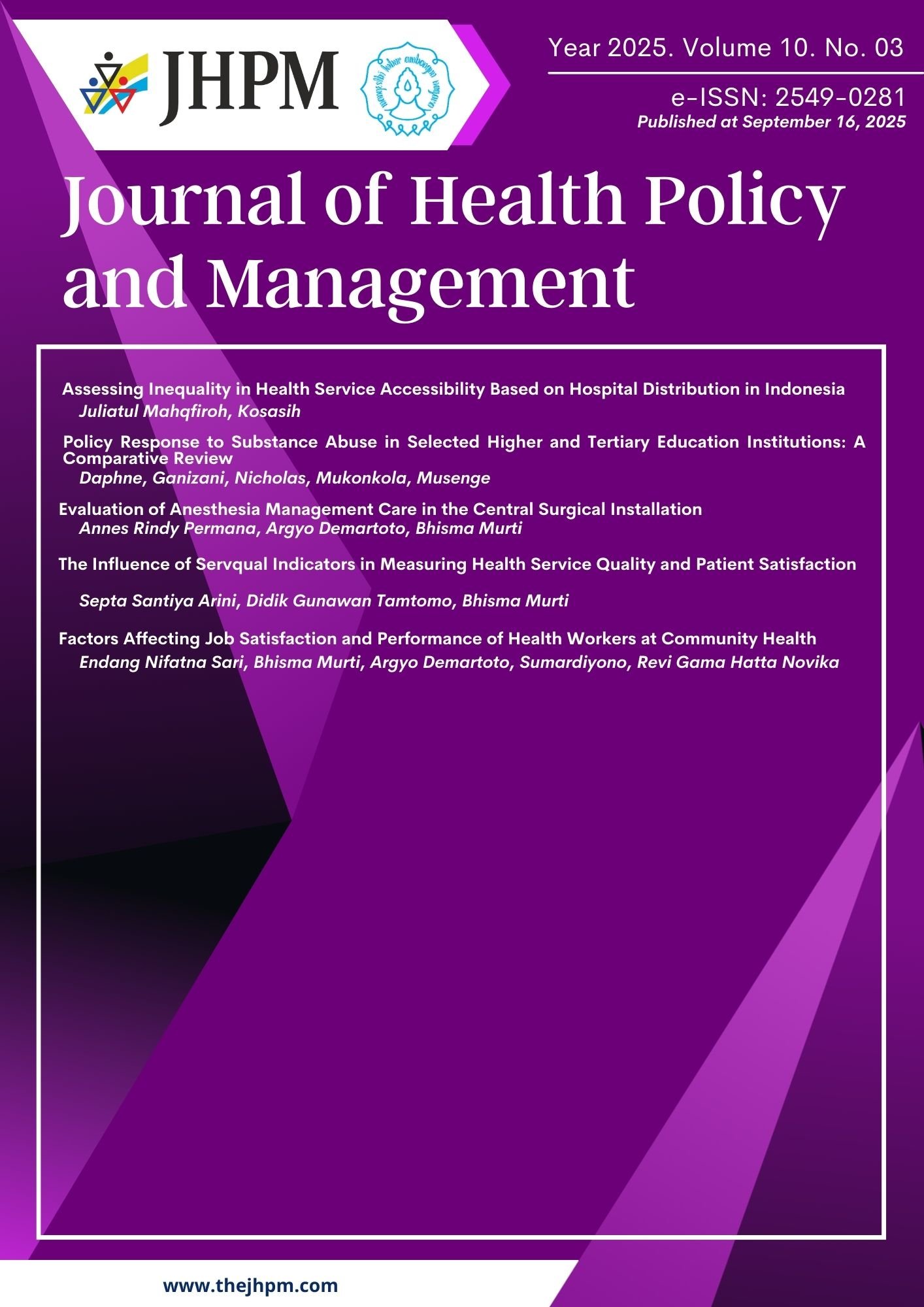Evaluation of Anesthesia Management Care in the Central Surgical Installation
DOI:
https://doi.org/10.26911/thejhpm.2025.10.03.03.aAbstract
Background: Effective anesthesia management is essential to ensure patient safety, minimize perioperative complications, and promote optimal recovery. Comprehensive planning across the pre-, intra-, and postoperative phases allows anesthesiologists to deliver systematic and high-quality care. Evaluating each component of anesthesia services context, input, process, product, and outcome is crucial for maintaining professional standards and improving patient satisfaction. Therefore, this study aimed to evaluate anesthesia care arrangements (pre-, intra-, and postoperative) at the Central Surgical Installation of dr. Soepraoen Kesdam V/Brawijaya Malang Hospital using the CIPP evaluation model.
Subjects and Method: This qualitative evaluative study was conducted from June 1 to July 1, 2024, employing the Context, Input, Process, and Product (CIPP) framework. Five anesthesiologists were selected through probability sampling. Data were collected through in-depth interviews, direct observations, document reviews, and Focus Group Discussions, and analyzed through data reduction, classification, and interpretation.
Results: Evaluation of the context and input components showed that anesthesia services complied with professional standards and ASKAN guidelines, supported by adequate human resources, infrastructure, and standard operating procedures. The process component including assessment, diagnosis, intervention, implementation, evaluation, and documentation was implemented adequately but not fully aligned with the ASKAN guidelines. Product evaluation indicated satisfactory documentation quality with partial conformity to the 2023 ASKAN edition. The outcome showed stable patient hemodynamics and high satisfaction levels.
Conclusion: Context and input components were well-implemented, while process and product evaluations were adequate but require improved documentation to align with the latest ASKAN standards.
Keywords:
anesthesia care, patient safety, perioperative managementHow to Cite
References
Aprilia AKD, Nurmawati I, Wijayanti RA (2020). Identification of causes of delays in provision of outpatient medical record documents at Husada Utama Hospital Surabaya in 2020 (Identifikasi Penyebab Keterlambatan Penyediaan Dokumen Rekam Medis Rawat Jalan di Rumah Sakit Husada Utama Surabaya Tahun 2020). Jurnal Rekam Medik Dan Informasi Kesehatan, 1(4): 630–638. https://doi.org/10.25047/j-remi.v1i4.2130.
Cherpanath T, Aarts L, Groeneveld J, Geerts B (2014). Defining fluid responsiveness: A guide to patient tailored volume titration. J Cardiothorac Vasc Anesth, 28(3): 745–754. https://doi.org/10.1053/j.jvca.2013.12.025.
Gandomkar R, Jalili M, Mirzazadeh A (2015). Evaluating assessment programmes using programme evaluation models. Med Teach, 37(8): 792–793. https://doi.org/10.3109/0142159X.2015.1042436.
Huygh J, Peeters Y, Bernards J, Malbrain MLNG (2016). Hemodynamic monitoring in the critically ill: An overview of current cardiac output monitoring methods. F1000Research, 5(F1000 Faculty Rev): 2855. https://doi.org/10.12688/f1000research.8991.1.
Julianto A, Fitriah A (2021). Evaluation of extracurricular Qur’an reading program at SMP Negeri 03 Bengkulu Selatan (Evaluasi Program Ekstrakurikuler Baca Al-Qur’an di SMP Negeri 03 Bengkulu Selatan). Jurnal Pendidikan Islam Al-Affan, 1(2): 175–184. https://doi.org/10.69775/jpia.v1i2.28.
Kementerian Kesehatan Republik Indonesia (2016). The State Gazette of the Republic of Indonesia No. 719, 2016 concerning Regulation of the Minister of Health of the Republic of Indonesia No. 18 of 2016 on Licensing and Implementation of Anesthesia Practice (Berita Negara Republik Indonesia No. 719 Tahun 2016 tentang Peraturan Menteri Kesehatan Republik Indonesia No. 18 Tahun 2016 tentang Izin dan Penyelenggaraan Praktik Penata Anestesi). 719: 1–18.
Keputusan Menteri Kesehatan Republik Indonesia (2020). Decree of the Minister of Health of the Republic of Indonesia No. HK.01.07/MENKES/722/2020 on Professional Standards for Anesthesia Technologists (Keputusan Menteri Kesehatan Republik Indonesia Nomor HK.01.07/MENKES/722/2020 tentang Standar Profesi Penata Anestesi).
Lagantondo H, Pandipa AKH, Thomassawa R (2023). Analysis of the implementation of the evaluation of community empowerment programs in Tiwaa Village (Analisis Pelaksanaan Evaluasi Program Pemberdayaan Masyarakat di Desa Tiwaa). SOSIOLOGI: Jurnal Ilmiah Kajian Ilmu Sosial dan Budaya, 25(1): 54–71. https://doi.org/10.23960/sosiologi.v25i1.
Lee SY, Shin JS, Lee SH (2019). How to execute context, input, process, and product evaluation model in medical health education. J Educ Eval Health Prof, 16: 1–8. https://doi.org/10.3352/JEEHP.2019.16.40.
Lestari S, Rosana D (2019). The development of CIPP evaluation model instruments on the application of science project learning assessment. Proceedings ICRIEMS 4, 1: 57–64. https://doi.org/10.54396/alfahim.v5i1.543.
Meeusen V, Ouellette S, Horton B (2016). The global organization of nurses in anesthesia: The International Federation of Nurse Anesthetists. Trends Anaesth Crit Care, 6: 20–25. https://doi.org/10.1016/j.tacc.2016.03.001.
Mirzazadeh A, Gandomkar R, Hejri SM, Hassanzadeh G, Koochak HE, Golestani A, Jafarian A, et al. (2016). Undergraduate medical education programme renewal: A longitudinal context, input, process and product evaluation study. Perspect Med Educ, 5(1): 15–23. https://doi.org/10.1007/s40037-015-0243-3.
Pantaleon L (2019). Why measuring outcomes is important in health care. J Vet Intern Med, 33(2): 356–362. https://doi.org/10.1111/jvim.15458.
Pramono (2015). Anesthesiology Textbook (Buku Kuliah Anestesi). Jakarta: EGC.
Progmet M, Morrell M, Nicholson M, Lake R, Long J (2016). Vital sign monitoring on general wards: Clinical staff perception of current practices and the planned introduction of continuous monitoring technology. Int J Qual Health Care, 28(4): 515–521. https://doi.org/10.1093/intqhc/mzw062.
Setiabudi IKA, Lewar EI, Suryanto Y, Saifudin I, Handayani RN, Wahyudi FM, Maharyawan IWA (2023). Anesthesiology Nursing Care / Anesthesia Care (Asuhan Keperawatan Anestesiologi / Asuhan Kepenataan Anestesi - ASKAN) (Edisi I). Purwokerto: UHB Press.
Sirait RH (2016). Hemodynamic Monitoring in Patients (Pemantauan Hemodinamik Pasien). Jakarta: FK UKI.
Steward D, Horton B, Madsen R, Rowles J, Akalu L, Debout C, Yang H (2021). Guidelines on Advanced Practice Nursing Nurse Anesthetists 2021. Geneva: International Council of Nurses.
Theodos B, Firschein J (2015). Evaluating community change programs. In: Handbook of Practical Program Evaluation (4th Edition), pp. 259–280. https://doi.org/10.1002/9781119171386.ch11.
Wahyudi FM, Suryanah A, Juarta T, Lidya NI (2023). Implementation of the Minister of Health Decree No. 722 of 2020 on Professional Standards for Anesthesia Technologists (Implementasi KMK No. 722 Tahun 2020 tentang Standar Profesi Penata Anestesi). JKKI, 12(1): 60–65. https://doi.org/10.22146/jkki.79992.





